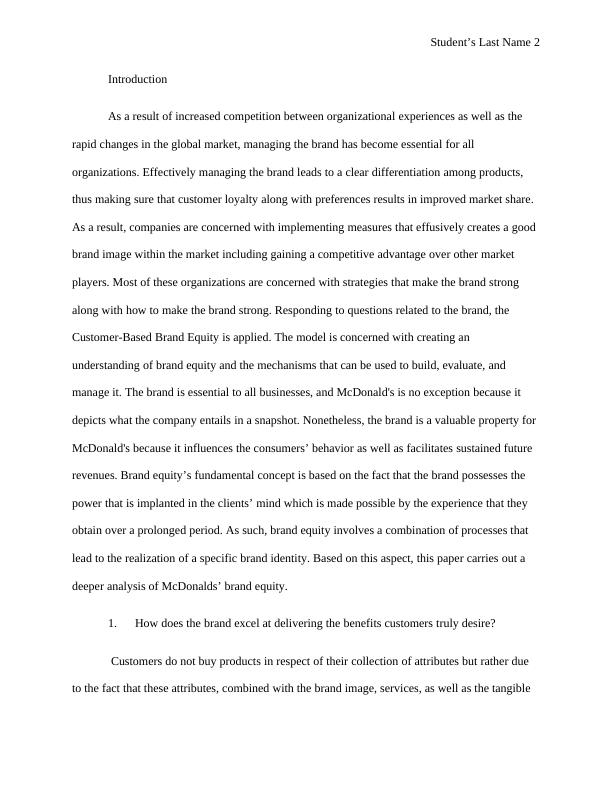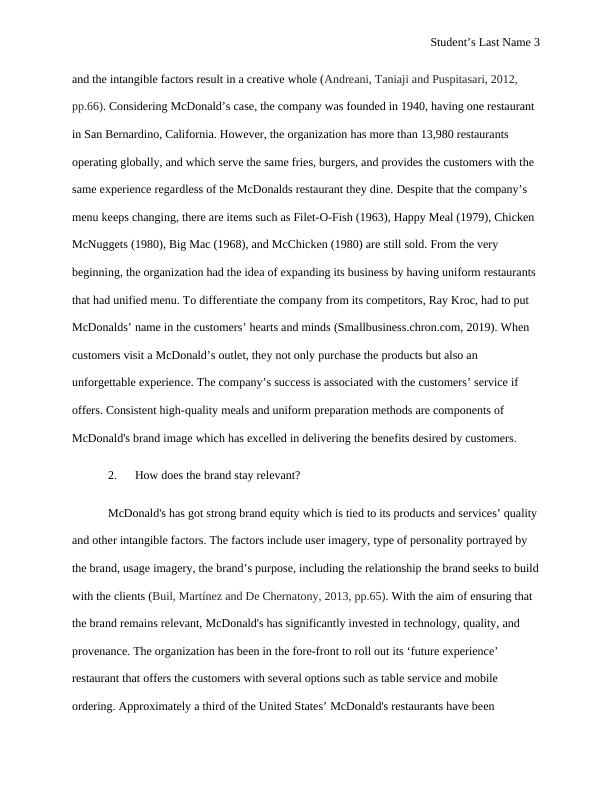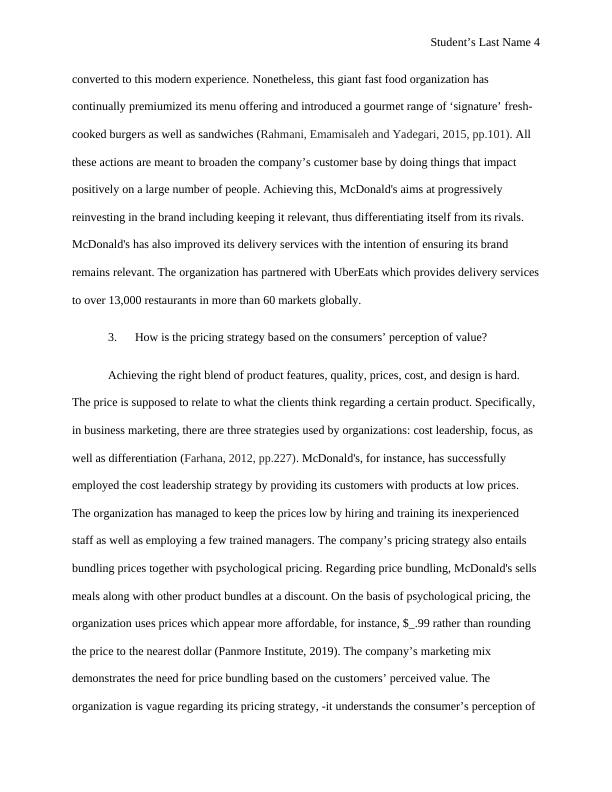Brand Management: Analyzing McDonald's Brand Equity
Added on 2023-02-01
14 Pages4021 Words56 Views
Student’s Last Name 1
Brand Management
By (Name)
Course
Professor
University
Date
Brand Management
By (Name)
Course
Professor
University
Date

Student’s Last Name 2
Introduction
As a result of increased competition between organizational experiences as well as the
rapid changes in the global market, managing the brand has become essential for all
organizations. Effectively managing the brand leads to a clear differentiation among products,
thus making sure that customer loyalty along with preferences results in improved market share.
As a result, companies are concerned with implementing measures that effusively creates a good
brand image within the market including gaining a competitive advantage over other market
players. Most of these organizations are concerned with strategies that make the brand strong
along with how to make the brand strong. Responding to questions related to the brand, the
Customer-Based Brand Equity is applied. The model is concerned with creating an
understanding of brand equity and the mechanisms that can be used to build, evaluate, and
manage it. The brand is essential to all businesses, and McDonald's is no exception because it
depicts what the company entails in a snapshot. Nonetheless, the brand is a valuable property for
McDonald's because it influences the consumers’ behavior as well as facilitates sustained future
revenues. Brand equity’s fundamental concept is based on the fact that the brand possesses the
power that is implanted in the clients’ mind which is made possible by the experience that they
obtain over a prolonged period. As such, brand equity involves a combination of processes that
lead to the realization of a specific brand identity. Based on this aspect, this paper carries out a
deeper analysis of McDonalds’ brand equity.
1. How does the brand excel at delivering the benefits customers truly desire?
Customers do not buy products in respect of their collection of attributes but rather due
to the fact that these attributes, combined with the brand image, services, as well as the tangible
Introduction
As a result of increased competition between organizational experiences as well as the
rapid changes in the global market, managing the brand has become essential for all
organizations. Effectively managing the brand leads to a clear differentiation among products,
thus making sure that customer loyalty along with preferences results in improved market share.
As a result, companies are concerned with implementing measures that effusively creates a good
brand image within the market including gaining a competitive advantage over other market
players. Most of these organizations are concerned with strategies that make the brand strong
along with how to make the brand strong. Responding to questions related to the brand, the
Customer-Based Brand Equity is applied. The model is concerned with creating an
understanding of brand equity and the mechanisms that can be used to build, evaluate, and
manage it. The brand is essential to all businesses, and McDonald's is no exception because it
depicts what the company entails in a snapshot. Nonetheless, the brand is a valuable property for
McDonald's because it influences the consumers’ behavior as well as facilitates sustained future
revenues. Brand equity’s fundamental concept is based on the fact that the brand possesses the
power that is implanted in the clients’ mind which is made possible by the experience that they
obtain over a prolonged period. As such, brand equity involves a combination of processes that
lead to the realization of a specific brand identity. Based on this aspect, this paper carries out a
deeper analysis of McDonalds’ brand equity.
1. How does the brand excel at delivering the benefits customers truly desire?
Customers do not buy products in respect of their collection of attributes but rather due
to the fact that these attributes, combined with the brand image, services, as well as the tangible

Student’s Last Name 3
and the intangible factors result in a creative whole (Andreani, Taniaji and Puspitasari, 2012,
pp.66). Considering McDonald’s case, the company was founded in 1940, having one restaurant
in San Bernardino, California. However, the organization has more than 13,980 restaurants
operating globally, and which serve the same fries, burgers, and provides the customers with the
same experience regardless of the McDonalds restaurant they dine. Despite that the company’s
menu keeps changing, there are items such as Filet-O-Fish (1963), Happy Meal (1979), Chicken
McNuggets (1980), Big Mac (1968), and McChicken (1980) are still sold. From the very
beginning, the organization had the idea of expanding its business by having uniform restaurants
that had unified menu. To differentiate the company from its competitors, Ray Kroc, had to put
McDonalds’ name in the customers’ hearts and minds (Smallbusiness.chron.com, 2019). When
customers visit a McDonald’s outlet, they not only purchase the products but also an
unforgettable experience. The company’s success is associated with the customers’ service if
offers. Consistent high-quality meals and uniform preparation methods are components of
McDonald's brand image which has excelled in delivering the benefits desired by customers.
2. How does the brand stay relevant?
McDonald's has got strong brand equity which is tied to its products and services’ quality
and other intangible factors. The factors include user imagery, type of personality portrayed by
the brand, usage imagery, the brand’s purpose, including the relationship the brand seeks to build
with the clients (Buil, Martínez and De Chernatony, 2013, pp.65). With the aim of ensuring that
the brand remains relevant, McDonald's has significantly invested in technology, quality, and
provenance. The organization has been in the fore-front to roll out its ‘future experience’
restaurant that offers the customers with several options such as table service and mobile
ordering. Approximately a third of the United States’ McDonald's restaurants have been
and the intangible factors result in a creative whole (Andreani, Taniaji and Puspitasari, 2012,
pp.66). Considering McDonald’s case, the company was founded in 1940, having one restaurant
in San Bernardino, California. However, the organization has more than 13,980 restaurants
operating globally, and which serve the same fries, burgers, and provides the customers with the
same experience regardless of the McDonalds restaurant they dine. Despite that the company’s
menu keeps changing, there are items such as Filet-O-Fish (1963), Happy Meal (1979), Chicken
McNuggets (1980), Big Mac (1968), and McChicken (1980) are still sold. From the very
beginning, the organization had the idea of expanding its business by having uniform restaurants
that had unified menu. To differentiate the company from its competitors, Ray Kroc, had to put
McDonalds’ name in the customers’ hearts and minds (Smallbusiness.chron.com, 2019). When
customers visit a McDonald’s outlet, they not only purchase the products but also an
unforgettable experience. The company’s success is associated with the customers’ service if
offers. Consistent high-quality meals and uniform preparation methods are components of
McDonald's brand image which has excelled in delivering the benefits desired by customers.
2. How does the brand stay relevant?
McDonald's has got strong brand equity which is tied to its products and services’ quality
and other intangible factors. The factors include user imagery, type of personality portrayed by
the brand, usage imagery, the brand’s purpose, including the relationship the brand seeks to build
with the clients (Buil, Martínez and De Chernatony, 2013, pp.65). With the aim of ensuring that
the brand remains relevant, McDonald's has significantly invested in technology, quality, and
provenance. The organization has been in the fore-front to roll out its ‘future experience’
restaurant that offers the customers with several options such as table service and mobile
ordering. Approximately a third of the United States’ McDonald's restaurants have been

Student’s Last Name 4
converted to this modern experience. Nonetheless, this giant fast food organization has
continually premiumized its menu offering and introduced a gourmet range of ‘signature’ fresh-
cooked burgers as well as sandwiches (Rahmani, Emamisaleh and Yadegari, 2015, pp.101). All
these actions are meant to broaden the company’s customer base by doing things that impact
positively on a large number of people. Achieving this, McDonald's aims at progressively
reinvesting in the brand including keeping it relevant, thus differentiating itself from its rivals.
McDonald's has also improved its delivery services with the intention of ensuring its brand
remains relevant. The organization has partnered with UberEats which provides delivery services
to over 13,000 restaurants in more than 60 markets globally.
3. How is the pricing strategy based on the consumers’ perception of value?
Achieving the right blend of product features, quality, prices, cost, and design is hard.
The price is supposed to relate to what the clients think regarding a certain product. Specifically,
in business marketing, there are three strategies used by organizations: cost leadership, focus, as
well as differentiation (Farhana, 2012, pp.227). McDonald's, for instance, has successfully
employed the cost leadership strategy by providing its customers with products at low prices.
The organization has managed to keep the prices low by hiring and training its inexperienced
staff as well as employing a few trained managers. The company’s pricing strategy also entails
bundling prices together with psychological pricing. Regarding price bundling, McDonald's sells
meals along with other product bundles at a discount. On the basis of psychological pricing, the
organization uses prices which appear more affordable, for instance, $_.99 rather than rounding
the price to the nearest dollar (Panmore Institute, 2019). The company’s marketing mix
demonstrates the need for price bundling based on the customers’ perceived value. The
organization is vague regarding its pricing strategy, -it understands the consumer’s perception of
converted to this modern experience. Nonetheless, this giant fast food organization has
continually premiumized its menu offering and introduced a gourmet range of ‘signature’ fresh-
cooked burgers as well as sandwiches (Rahmani, Emamisaleh and Yadegari, 2015, pp.101). All
these actions are meant to broaden the company’s customer base by doing things that impact
positively on a large number of people. Achieving this, McDonald's aims at progressively
reinvesting in the brand including keeping it relevant, thus differentiating itself from its rivals.
McDonald's has also improved its delivery services with the intention of ensuring its brand
remains relevant. The organization has partnered with UberEats which provides delivery services
to over 13,000 restaurants in more than 60 markets globally.
3. How is the pricing strategy based on the consumers’ perception of value?
Achieving the right blend of product features, quality, prices, cost, and design is hard.
The price is supposed to relate to what the clients think regarding a certain product. Specifically,
in business marketing, there are three strategies used by organizations: cost leadership, focus, as
well as differentiation (Farhana, 2012, pp.227). McDonald's, for instance, has successfully
employed the cost leadership strategy by providing its customers with products at low prices.
The organization has managed to keep the prices low by hiring and training its inexperienced
staff as well as employing a few trained managers. The company’s pricing strategy also entails
bundling prices together with psychological pricing. Regarding price bundling, McDonald's sells
meals along with other product bundles at a discount. On the basis of psychological pricing, the
organization uses prices which appear more affordable, for instance, $_.99 rather than rounding
the price to the nearest dollar (Panmore Institute, 2019). The company’s marketing mix
demonstrates the need for price bundling based on the customers’ perceived value. The
organization is vague regarding its pricing strategy, -it understands the consumer’s perception of

End of preview
Want to access all the pages? Upload your documents or become a member.
Related Documents
Brand Strategy of McDonald: Emotion, Symbolic Meaning, and Brand Equitylg...
|10
|2502
|50
Brand Management: Building and Managing Brand Equitylg...
|11
|3261
|391
The International Market Strategy of Mcdonaldslg...
|4
|855
|81
Impact of Branding on Customer Buying Behaviour in Fashion Sectorlg...
|9
|1874
|65
How Brand is built and managed over timelg...
|17
|4204
|234
Brand Management Assignment (Solved)lg...
|17
|6702
|393